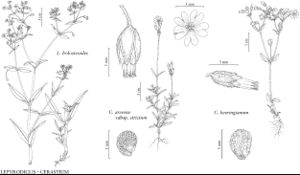Cerastium arvense subsp. strictum
Fl. Helv. 3: 245. 1828.
Plants forming clumps or mats, rhizomatous, or tufted, taprooted; straggling, creeping shoots usually not well developed. Stems: flowering-stems decumbent at base, usually green or straw colored, occasionally purple-tinged (in some populations growing on serpentine rocks), 5–20 (–30) cm, pubescent and often glandular distally, hairs patent or deflexed; nonflowering winter shoots, when present, elongating, with narrow, oblanceolate leaves; small axillary tufts of leaves always present. Leaves usually not strongly dimorphic; blade lanceolate or oblanceolate to linear, 2–25 × 1–5 mm. Flowers: sepals 3.5–6 (–7) mm, midrib visible; petals 7.5–9 mm (–12 mm in western plants), usually remaining ± white when dried; anthers 0.8–0.9 mm. Capsules 7.5–11 × 2.5–4 mm, usually less than 1.5 times as long as sepals, rarely longer. Seeds 0.6–1.1 mm. 2n = 36.
Phenology: Flowering spring.
Habitat: Prairie grasslands, roadsides, arctic and alpine tundra, shores, dunes and rocky plains, rocky outcrops, alvars, sea cliffs and banks, favoring neutral to alkaline soils
Elevation: 0-3800 m
Distribution

Greenland, St. Pierre and Miquelon, Alta., B.C., Man., N.B., Nfld. and Labr., N.W.T., N.S., Nunavut, Ont., P.E.I., Que., Sask., Yukon, Alaska, Ariz., Calif., Colo., Conn., Idaho, Ind., Iowa, Maine, Md., Mass., Mich., Minn., Mo., Mont., Nebr., Nev., N.H., N.J., N.Mex., N.Y., N.Dak., Ohio, Oreg., Pa., S.Dak., Utah, Vt., Va., Wash., W.Va., Wis., Wyo., Europe (Alps), South America (s to Tierra del Fuego)
Discussion
Subspecies strictum is widely distributed and grows in a great diversity of habitats, making it difficult to circumscribe and distinguish, both from subsp. arvense and from forms of Cerastium beeringianum, C. velutinum, and C. viride. Forms of subsp. strictum growing at high elevations or latitudes often develop broader leaves and may be confused with C. beeringianum (S. J. Wagstaff and R. J. Taylor 1988). However, C. arvense always has small axillary tufts of leaves. In northern parts of the Ungava region of Labrador, subsp. strictum appears on occasion to intergrade with C. alpinum. The status of these plants is uncertain.
Subspecies strictum is a remarkably variable taxon. Plants from the western side of the continent often have larger petals and a ranker growth. Completely glabrous plants (var. ophiticola) occur on serpentine in southern Quebec. Plants with broader ovate-elliptic leaves and tomentose pubescence (similar to Cerastium velutinum var. villosissimum but smaller) occur in the same area. Populations on the limestone plains near Belleville, southern Ontario, are more robust, with broader, strongly marcescent leaves at the base and a woolly pubescence. Plants from river valleys in Idaho tend to be much larger, with long, very narrow leaves; these are the basis for the name C. graminifolium. However, all of these plants are completely interfertile and show no reduction in fertility when crossed. Most of this variation is under genic control but also is affected by environmental factors.
Subspecies strictum is not interfertile with subsp. arvense or with other similar taxa such as Cerastium beeringianum, C. velutinum, and C. viride. Differences in chromosome numbers present an effective barrier to interfertility. However, several sterile hybrids involving subsp. strictum and those species have been synthesized. Many workers, most recently R. E. Ugborogho (1977), have included C. velutinum and C. viride in C. arvense as varieties or subspecies. However specific status is more appropriate because of the strong sterility barriers between them and the presence of morphological characters that enable them to be distinguished, albeit with difficulty in some herbarium material. This difficulty arises from the remarkable degree of variation displayed by subsp. strictum.
Selected References
None.
Lower Taxa
"-1.5timesaslongassepals" is not declared as a valid unit of measurement for this property."-6timesaslongassepals" is not declared as a valid unit of measurement for this property.
